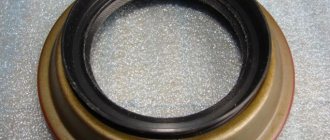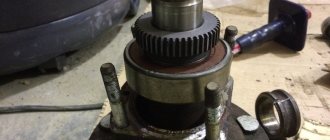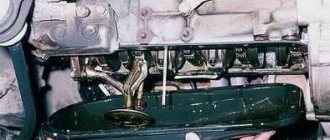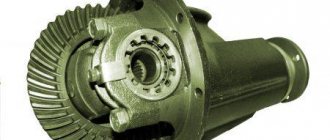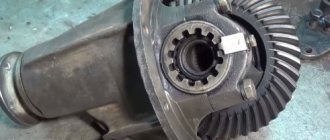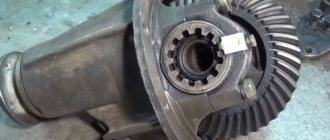Why do they pour? mWhat about the rear axle gearbox? Timely filling of oil fluid into the rear axle gearbox is necessary to improve the interaction of unit parts and extend their service life. Typically, automobile components break down due to wear and tear and poor maintenance.
Fault prevention makes it possible to prevent the occurrence of various problems in the unit. You need to understand how the oil is changed in the transfer case and rear gearbox, and be able to choose what kind of oil to pour into the rear axle gearbox.
When to change
The replacement frequency is on average 50 thousand kilometers for cars with a manual transmission, and 30 thousand for an automatic one.
It is more often necessary to change the oil on cars that are used in difficult conditions, which include:
In a new car, it is recommended to replace it after the first 2-3 thousand mileage. The fact is that at the initial stage of work, new components undergo the so-called “grinding in”, which is characterized by increased formation of wear products.
Many car owners change the oil in the gearbox at the same time as the manual transmission, since both units use transmission fluid.
Be sure to check the level and condition of the oil in the gearboxes after purchasing a car on the secondary market. Usually, before selling, owners change lubricants only in places where they can be easily checked. Gearboxes are not one of these.
How often to change
There are several different types of transfer cases, and depending on the type of mechanism, the frequency of replacement can vary significantly. Usually this information is contained in the technical documentation for the car and varies in the range from 50 to 100 thousand kilometers.
In addition, operating conditions affect the service life. The transfer case of a car that drives on public roads experiences much less load than that installed on a car that constantly moves off-road.
Checking the level and condition of the oil in the gearbox
The level and condition of the oil in the gearbox is checked “cold”, when all the liquid collects in the crankcase.
The oil should be at the level of the filler hole, 2-5 millimeters below. To check, unscrew the filler plug and use a stick, wire, finger, or other improvised means to find out the level. The condition can be checked here by taking a small amount of liquid with a syringe and tube.
You can also assess the condition of the lubricant by unscrewing the drain plug for a few seconds. Tighten the filler first, so the oil will flow much more slowly. If the car has been sitting for several hours before, all foreign particles will settle in the crankcase, and you will get a clearer picture of the condition of the oil.
The presence of metal particles in the waste indicates that the gearbox components have a high degree of wear, and serious repairs and replacement of parts may soon be necessary.
Oil type: how to choose?
Let us recall that the market, in principle, can provide only three types of oil to choose from:
- synthetics;
- semi-synthetic;
- mineral water
If you want to provide the bridge with the most comfortable conditions for operation, of course, the choice should be synthetic oil. In addition, we recall that the classification of oils is additionally carried out according to seasons of use.
An example is the recommendations of the UAZ technical department. They recommend using all-season oil type SAE 75W/90 on the UAZ Patriot. The advantage of such a solution is accessibility in the first place.
However, in view of changing weather conditions (all climatic seasons are present on the territory of the Russian Federation), it is better to give preference to a specific type of oil (we are talking about the season - summer or winter).
What and how much to fill
It is best to fill the gearbox with gear oil recommended by the manufacturer. Information is indicated in the technical documentation, and it is very important to focus on compliance with the API class.
Almost all modern automakers require the use of oils of at least GL-4 and GL-5 in their transmissions, gearboxes and transfer cases, which contain extreme pressure and other additives and are adapted to work in the most severe conditions.
If you don’t know what kind of oil and how much is poured into the gearbox of your car, look for it in the table. We have collected information on approvals for various vehicles from many available sources.
If the car has 2 or 3 axles, then the total amount of fluid is indicated.
LSD (Limited Slip Differential) - self-locking differential, or limited slip differential.
| Automobile | Oil | Volume (l) |
| VAZ | ||
| 2101 | 80W90 or 75W90 | 1,50 |
| 2105/2106 | Lukoil 80W90 GL-5, TAD-17 80W-90 | 1,30 |
| 2107 | CASTROL Syntrans Transaxle 75W-90 API GL-4, Lukoil 80W90 GL-5 | 1,50 |
| 2121 | Lukoil TM-5 (75W-90, 80W-90, 85W-90), TNK Trans Gipoid (80W-90) | 2,50 |
| GAS | ||
| 53 | TAD-17 (TM-5-18) | 8,20 |
| 66 | TSP-14gip, TAp-15V, TAD-17i, TEp-15 | 14,10 |
| Valdai | TM5-18, TAD-17, Castrol Axle EPX 80W-90 | 8,00 |
| Next | Shell Spirax S5 ATE 75W-90, YOKO 75 W 90, TOTAL TRANS SYN FE 75W90, LIQUI MOLI GL4/GL5 75W90 | 2,70 |
| Business | 75W90, 80W90 | 2,30 |
| 3110/31105 (Volga) | THK Trans 80W-90, ZIC G-5 80W90, TM-5 85-90 Lukoil | 1,70 |
| 3307/3309 | TSp-14gip, SAE 85W-90, 75W-90 | 8,20 |
| ZIL | ||
| 130 | TAD-17i (TM-5-18), 80W90 GL-5 | 10,50 |
| 131 | TSp-15K API GL-3 | 15,00 |
| 5301 (Goby) | TSp-14gip, TAD-17 (TM5-18) 80W90 Gl-5 | 3,30 |
| KAMAZ | ||
| 4308 | TSP-15k (TM-3-18) | 7,50 |
| 43118 | TSp-15K | 20,00 |
| 5320 | TSP-15k (TM-3-18) | 14,00 |
| 6520 | TSP-15k (TM-3-18), TAD-17 (TM-5-18), ZIC GFT 75W-90, Castrol Syntrax Long Life 75W-90 | 14,00 |
| LUAZ | ||
| 969 | TM5-18, TAD-17 | 1,40 |
| MAZ | ||
| 5516 | TM-5, tsp-15k | 15,00 |
| MOSKVICH | ||
| 412 | TAD-17 Type TM-5-18 80W-90, 75W90 GL-5, | 1,20 |
| 2140 | 80W90GL-5 | 1,30 |
| UAZ | ||
| Patriot | SAE 75W/90 API GL-5, Zic GF Top 75W-85, Castrol Syntrax Long Life 75W90 | 2,70 |
| AUDI | ||
| A6 C6 | SAE 75W90 GL-5 (MOTUL Gear 300 LS) | 2,40 |
| A4 | G 052 145 S 2 | 1,50 |
| BMW | ||
| x5 f10 | BMW 33 11 7 695 240 "SAF-XO 75W-90 | 1,60 |
| x5 e60 | Castrol SAF-XO 75w90, Motul 75W90, MOTUL Gear Competition 75W-140 | 2,60 |
| x3 e36 (with lock) | 75W140 (CASTROL SYNTRAX LIMITED SLIP GL-5) | 2,00 |
| x3 e36 (without locking) | 75W90 GL-5 | 2,00 |
| x3 e90 | Syntrax 75w90 | 1,00 |
| x5 e70 | Castrol SYNTRAX LONG LIFE 75W-90 | 2,00 |
| x5 e53 | Castrol Syntrax Longlife (SAF-XO) 75W-90, SYNTRAX 75W90 | 2,00 |
| x5 e34 (with lock) | 75W140 (CASTROL SYNTRAX LIMITED SLIP GL-5) | 1,70 |
| x5 e34 (without locking) | 75W90 GL-5 | 1,70 |
| x5 e39 | 75W90 GL-5 | 1,20 |
| m5 e39 | Сasrtrol Syntrax Limited Slip 75W-140 | 1,20 |
| CADILLAC | ||
| CTS | 75W90 | 2,00 |
| CHEVROLET | ||
| Niva | 80W-90 GL-4 | 2,50 |
| Captiva | Castrol SYNTRAX UNIVERSAL 75W90 | 0,60 |
| TrailBlazer | 75W90 GL-4/GL-5 | 3,00 |
| FORD | ||
| Explorer 5 | Castrol Syntrax Limited Slip 75w140 | 1,20 |
| EcoSport | Comma SX1L 75W90 Gl5 | 1,00 |
| Maverick | 80W90, 75W140 (Liqui Moly SAE 80W-90) | 1,50 |
| Transit | GL4/5 75W90/75W-140 | 3,00 |
| Kuga 2 | SAE 80W-90F | 1,20 |
| GREAT WALL | ||
| Safe | API GL-5 80W90, 75W90 GL-5 | 5,00 |
| Wingle 5 | 80W90Gl5 | 4,30 |
| HAMMER | ||
| H3 | SAE 75W90 class GL-5 | 3,80 |
| HONDA | ||
| CR-V 1 | Honda DPF II | 1,00 |
| CR-V 2 | DPS-F | 1,40 |
| CR-V 3 | Honda DPS-F | 1,40 |
| CR-V 4 | DPSF-II | 1,40 |
| Stepwagon | DPF II (DPS-F) 082009007 | 1,20 |
| HYUNDAI | ||
| Santa Fe | Shell Spirax AXME 75W90 | 1,00 |
| Santa Fe (limited slip gearbox) | CASTROL SYNTRAX LIMITED SLIP (75W-140) | 1,00 |
| ix35 | 75W90 | 0,80 |
| Tucson | 80W90 GL-4/Gl-5 (Shell Spirax S3 AX 80W-90), 75W90 GL-5 (Сastrol Syntrax Universal 75W-90) | 0,90 |
| Galloper | SAE 80W90 API GL5, 75W90 GL-5 (Mobilube Syn LS 75W-90, Castrol SAF-XJ 75W-140) | 3,50 |
| Grand Starex | GL-5 75W-90 | 2,20 |
| Porter | SAE GL-5 75w90, 75W140 | 2,80 |
| KIA | ||
| Sorento 2 | Castrol Syntrax Universal Plus 75W90, RAVENOL TGO 75W90 | 1,00 |
| Sportage 2 | 75W90 GL-5 (Mobil Mobilube HD 75W90 GL-5, CASTROL 4008177071768 "Syntrax Longlife 75W-90) | 0,80 |
| Sportage 3 | GL5 75W90 LSD, Liqui Moly SAE 75W-90 GL5 | 0,65 |
| LAND ROVER | ||
| Evoque | Castrol Syntrax Long Life 75w90 | 2,00 |
| Freelander | LR003156, Castrol Syntrax Long Life 75W-140 | 0,70 |
| Freelander 2 | Castrol EPX oil | 0,70 |
| Range rover (front) | CASTROL SYNTRAX LONG LIFE 75W-90 | 0,80 |
| Range rover (rear without locking) | CASTROL SYNTRAX LONG LIFE 75W-90 | 1,60 |
| Range rover (rear with locking) | Castrol SAF-XJ 75W-140 | 1,80 |
| Discovery 3 | Castrol SAF-XO | 1,70 |
| LEXUS | ||
| Is 250 | Toyota Gear Oil LT 75W-85, Castrol TAF-X 75W90 | 2,00 |
| Rx 300 | 80-W90 | 0,90 |
| MAN | ||
| TGA | syntrax longlife 75w-90 | 15,00 |
| MAZDA | ||
| CX-5 | Neste Hypoidi S 75w-90 GL-5 | 0,45 |
| CX-7 | API GL-4/GL-5 80W90 | 1,00 |
| Titan | 75W90 GL-5, 80W90 Gl4/Gl5 | 3,00 |
| MERCEDES | ||
| Atego | 80W-90, 85W/90, 75W-90 | 6,80 |
| M.L. | 85W90GL5 | 3,00 |
| w123 | SAE 85W90 Gl5, SAE 80W890 GL5 | 2,00 |
| w124 | MB 235.0 - 85W90, MB 235.7 A 75W-90 (Spirax S6 AXME 75W-90, Fuchs TITAN SINTOPOID FE 75W-85, Mobilube FE 75W-85) | 1,10 |
| w164 (without blocking) | 235.7/235.74 a0019893303 | 2,20 |
| w164 (rear with locking) | 235.15 a0019895903 | 1,60 |
| w202 | 75W85 | 1,00 |
| w203/210 | MERCEDES A «75W-85, Fuchs TITAN SINTOPOID FE 75W-85 | 1,00 |
| w204/w211/w212 | 235.7 (75W90) | 1,60 |
| w204/w211/w212 (rear 204.077/277) | 236.61 (75W140) | 1,20 |
| Sprinter | Castrol Syntrans Multivehicle 75W-90, TITAN SINTOFLUID FE SAE 75W | 1,80 |
| Gelandwagen | 75W90 Gl-4/GL-5, 75W85, 75W140 | 3,00 |
| MITSUBISHI | ||
| Outlander xl | 80W90 Gl-5, 75W90 GL-5 (Motul GEARBOX 80W-90, MOBILUBE 1 SHC 75W-90, Eneos gear 80W90 Gl-5) | 0,50 |
| Delica | 80W90GL-4 | 2,50 |
| Pajero Sport (front) | Castrol syntrax long life 75W-90 | 0,90 |
| Pajero Sport (rear with LSD) | Mobilube SYN LS 75W-90, Mobil 1 Synthetic Gear Lube LS 75W-90 | 2,60 |
| Pajero Sport (rear without LSD) | Castrol syntrax long life 75W-90 | 2,60 |
| L200 | GL-5 SAE 80W | 3,80 |
| Pajero 4 | GL-5 SAE 80W | 2,75 |
| NISSAN | ||
| Atlas | SAE 75W90 Gl-4 | 2,00 |
| Pathfinder (front) | Nissan Differential fluid 80w-90 | 0,80 |
| Pathfinder (rear) | 75W-90 | 1,80 |
| Murano | Nissan GL5 ke907-99932 80w90 | 0,55 |
| NP300 | NISSAN KE907-99932 “Differential Oil 80W90 | 2,60 |
| X trail t31 | Nissan Differential Fluid (KE907-99932), Castrol Syntrax universal plus 75w90 GL-4/GL-5 | 0,60 |
| Juke | NISSAN DIFFERENTIAL FLUID SAE 80W-90 | 0,40 |
| Qashqai | API GL-5 SAE 80W-90 | 0,55 |
| OPEL | ||
| Antara | LM Hypoid-Getriebeoil TDL (GL-4/GL-5) 75W-90, MOBILUBE 1 SHC 75W-90 Gl4/GL5, Motul Gear 300 75W90 | 0,60 |
| Omega B | 90W 19 42 387 | 1,20 |
| PEUGEOT | ||
| 4007 | Total Transmission X4 GL-5 SAE90 | 0,50 |
| RENAULT | ||
| Duster | Elf TransElf Type B 80W90 | 0,25 |
| SCANIA | ||
| 113 | 80w140 | 13,00 |
| SKODA | ||
| Yeti | CASTROL Syntrax Longlife 75w90 | 2,00 |
| SSANGYONG | ||
| Rexton (front with IOP) | 80W90 | 1,00 |
| Rexton (front without IOP) | 75W90 | 1,00 |
| Rexton (rear continuous) | 80W90GL-5 | 1,50 |
| Rexton (rear IRS) | 75W90 | 1,50 |
| Actyon Sports | 80W90 API GL-5 | 3,30 |
| SUBARU | ||
| Forester | SAE 75W90 (MOTUL Gear 300 75w90, Castrol Syntrax Universal Plus) | 2,00 |
| Impreza/Legacy | API GL-5, SAE 75W90 (Gear 300 75W90) | 2,00 |
| Outback | 75W90GL5 | 2,20 |
| SUZUKI | ||
| Sx4 | Suzuki Gear Oil SAE 80W-90, SAE 80W-90 according to API GL-5 | 0,80 |
| Grand vitara | SAE 80W-90 API GL-5 | 1,80 |
| TOYOTA | ||
| Fielder | Hypoid Gear Oil SX API GL-5 SAE85W-90 | 0,50 |
| Highlander | LT 75W-85 GL-5 TOYOTA | 0,50 |
| Hiace | Toyota API GL-5 SAE80W-90 | 1,50 |
| Hilux | 75W90 | 4,60 |
| Rav 4 | Toyota Synthetic Gear Oil API GL4/GL5, SAE 75W-90 | 1,00 |
| Town Ace | Toyota Gear Oil SX GL-5 85w90 | 2,20 |
| Prado 80 | API 75W90 Gl-5 | 6,00 |
| Prado 100 | 75W90 GL4/GL5, Motul 75W90 Gear | 3,50 |
| Prado 120 | Toyota Gear Oil 80W-90 Gl-5 | 4,00 |
| Prado 120 (LSD) | Toyota Hypoid Gear Oil LSD 85W-90 | 4,00 |
| VOLKSWAGEN | ||
| Tiguan | 75W90 | 1,70 |
| Tuareg (front) | VAG G052145S2 75-w90 API GL-5 | 1,00 |
| Tuareg (rear with locking) | VAG G052196A2 75-w85 LS | 1,60 |
| Tuareg (rear without locking) | VAG G052145S2 | 1,30 |
| Crafter | VAG G 052 145 S2, VAG G 052512A2, Castrol Syntrax Long Life 75W-90 | 1,80 |
| VOLVO | ||
| XC60 | Volvo 80W API GL-5, 1161620 | 1,00 |
| CX90 | 80W-90 API GL-5 | 0,60 |
Lubricant selection criteria
Gearbox oil is selected individually, taking into account the characteristics of the machine. Transmission fluids differ in their composition and are used strictly for their intended purpose. Oil formulas are developed taking into account the operating temperatures of the mechanism, loads and rotation speeds of the elements.
Transmission fluids are graded by viscosity level. The following markings are used: 75W; 80W; 85W; 90; 140; 250. This series represents the main types of oils for automobile gearboxes.
On a note! Gear fluids are divided into summer, winter and all-season groups. The letter W in the marking of gear oils indicates that they belong to the winter category. Thus, 70W grease is suitable for temperatures down to minus 50°C, and 75W for minus 40°C.
The best solution is to fill the transmission oil recommended by the manufacturer. This information can be found in the technical documentation. In addition, it is recommended to take into account the API class of liquids. For manual and automatic passenger car transmissions, GL-4 or GL-5 category compounds are used, containing a full range of various additives to protect the mechanism.
If the car owner does not know what kind of oil and in what quantity to pour into the gearbox, he can look at special tables in which the type of fluid and its quantity are indicated for each brand of car. So, for example, for VAZ 2101 they use 80W90 or 75W90 oil in an amount of 1.5 liters, for models 2105/2106 1.3 liters - Lukoil 80W90 GL-5.
The oil is chosen taking into account the age of the car:
- Older machines allow the use of lower grade products. In earlier times, transmissions were made more coarsely, designed for light loads.
- Modern cars need the highest quality lubricants. The use of low-grade varieties is unacceptable.
The use of unsuitable fluids can damage both individual components and the entire mechanism.
Change of oil
It is better to replace it after traveling a short distance (5-10 kilometers). This will allow the oil in the gearbox to warm up and become less viscous.
The car should be in a horizontal position; it is most convenient to work in an inspection hole, on an overpass or using a lift. This will make it easier to get to the gearbox. Use a wire brush to clean the surface around the filler and drain holes.
It would be a good idea to pay attention to the condition of the oil seals; if they wear out, oil may leak out of the gearbox. If smudges are visible in the area of the seals, it is also better to change them immediately.
Why do they pour oil into the rear axle gearbox? Timely filling of oil fluid into the rear axle gearbox is necessary to improve the interaction of unit parts and extend their service life. Typically, automobile components break down due to wear and tear and poor maintenance.
Fault prevention makes it possible to prevent the occurrence of various problems in the unit. You need to understand how the oil is changed in the transfer case and rear gearbox, and be able to choose what kind of oil to pour into the rear axle gearbox.
How to choose
Two types of fluid are poured into the transfer case: transmission oil or ATF fluid.
On cars with an automatic transmission, ATF is usually filled into the transfer case, and on cars with a manual transmission, the transmission is filled. In this case, often the liquids must match or be completely compatible.
This is due to the fact that usually the connection between the transfer case and the gearbox is made by a single shaft, or one is attached to the body of the other. When mixing liquids, this will avoid the formation of emulsions, foaming and other side effects.
For most modern cars with a transfer case, the manufacturer recommends using GL-5 class gear oils. They protect hypoid gears well, are designed to operate in the most heavily loaded mechanisms and contain extreme pressure additives.
The viscosity characteristics of oils play an important role. Let's look at the meaning of the numbers using 80W90 oil as an example:
- 80 – viscosity at low temperatures
- W – all-season
- 90 – viscosity at high temperatures
If ATF is used, it is better to fill in the original fluid recommended by the manufacturer, or an analogue that has the appropriate approvals.
How does the rear axle work, why does it wear out?
The rear axle gearbox (transfer case) is a unit connected to each other that transmits torque from the power unit to the wheels. The gearbox is subjected to different loads, the degree of which depends on the speed. Because of this, friction appears in it, which has a destructive effect on its condition. In order to compensate for this effect, a special lubricant is used to soften the movement of moving parts and ensure their integrity. Changing the oil in the gearbox is an important procedure that should not be neglected.
The oil in the rear axle needs to be changed approximately once every thirty-five thousand kilometers. This replacement frequency is recommended by well-known car manufacturers. There are certain signs that, if detected, must immediately replace the consumable (having previously determined what kind of oil to pour into the rear axle gearbox). These include:
- reducing the amount of motor oil;
- the appearance of gray dust in the lubricant;
- changing the shade of the consumable.
The attractive qualities of mineral water and why semi-synthetics are better than others
The main advantage of mineral oil is its affordable cost. Due to the fact that it contains virtually no additives, the most attractive price for the end user is achieved.
In addition, the mineral oil poured into the bridge has sufficient viscosity so as not to penetrate the seals. The change in viscosity indicators with sudden temperature changes is insignificant.
The golden mean is semi-synthetics. It is not as expensive as fully synthetic axle oil, but at the same time it protects moving parts of the units more effectively than mineral oil.
It is important to change the oil on time, since without it metal shavings will accumulate inside. Ultimately, this may cause the mechanism to jam.
The video demonstrates the characteristics of domestic axle oil TAD-17:
The influence of harmful factors on the rear axle of the car
A decrease in the amount of lubricant may be due to a deterioration in its technical characteristics, leading to a change in the viscosity index. Also, the level of consumables may decrease due to normal leaks that occur due to increased loads.
The appearance of gray dust is a sign of worn parts. The outer layer of spare parts wears off over time and precipitates. Once in the car oil, the sediment begins to circulate throughout the lubricant complex. If it ends up on an important part, its holes may become partially blocked. This may cause damage. If this problem is detected, fresh lubricant should be poured into the gearbox immediately. If you find metal particles or shavings in your car oil, it means you need to overhaul the engine and completely replace damaged parts.
Algorithm for changing the oil in the rear axle gearbox
How is the oil changed in the rear axle gearbox? The algorithm is as follows:
- Place the car on a hill (overpass, inspection ditch). This is necessary for unhindered access to components located under the bottom of the machine.
- Warm up the engine. This will reduce the viscosity of the lubricant so that it drains faster.
- Remove the oil filler cap of the gearbox to assess the degree of wear of the consumable.
- Prepare a bucket to drain the used oil product.
- Remove the drain cover located at the bottom of the car.
- If the lubricant is dark in color or you notice foreign particles in it, you need to rinse the lubricant complex. You can use special fluids or regular car oil.
- Close the drain cap to prevent new oil from leaking out of the rear axle.
- Pour fresh consumables into the gearbox (to the edge of the hole). This can be done using a long rubber tube or a syringe, which allows you to pour the lubricant evenly without spilling it. Changing the oil in the rear axle is almost complete.
- Warm up the car and take it for a drive. This will allow fresh oil to pass through the entire lubrication complex, which will ensure the smooth functioning of the vehicle.
Now you know how to change the oil in the rear axle of a VAZ (and any other car). Changing the oil in the rear gearbox is a fairly simple procedure.
How to disassemble?
The gearbox must be lubricated as thoroughly as possible. Even noise can be eliminated if the deficiency of lubricants is replenished. But you should be as careful as possible when choosing a suitable brand of lubricant; the use of contaminated compounds is unacceptable.
It is worth considering that extraneous sounds are often associated with poor tightening of fasteners, wear of bearings and gears. To disassemble the gearbox, you need to:
- remove it;
- unscrew the screws;
- remove the protective caps;
- pull out the output shaft bushing;
- disconnect the lever and then the plug;
- remove the input shaft (in close connection with the gears);
- remove the shaft and chain bushings;
- dismantle the shaft and sprocket block;
- remove the intermediate shaft and gears;
- remove the coupling and axle shafts (assembly is carried out in the reverse order).
Which car oil to choose?
What kind of oil should I use? It is possible to use both mineral water and synthetics. Due to its own composition, synthetics resist wear better than mineral water made through petroleum refining, which must be changed frequently. The advantage of mineral oil is its fairly low price. Special additives are added to synthetics, which increase the service life of such motor oil several times. However, the cost of synthetic consumables, especially from well-known manufacturers, is quite high.
Before deciding what kind of oil to pour into the rear axle gearbox, remember that there are also semi-synthetic petroleum products. They are not as expensive as synthetic ones, but they have fairly high technical characteristics (constant viscosity index, excellent lubrication properties). It is not for nothing that semi-synthetics have become so popular among many car owners in the Russian Federation.
The rear axle gearbox is a part of rear-wheel drive and all-wheel drive cars. Transmission oil is poured into the rear axle gearbox. The engine crankshaft produces the energy that propels the car. If there were no gearbox, then the incoming energy would cause the wheels to rotate at a very high speed. In this case, the car would be impossible to drive. Since worm gearboxes are modules with a characteristic function of reducing motor torque, it is imperative to monitor the serviceability of such structures.
The wear of the gear teeth of the gearbox is associated with the entry and exit of the mesh. For this reason, the material for the manufacture of the gearbox is high quality hardened steel. Gearbox lubricant sometimes begins to leak through the seals when using the car. For a longer service life of the device, you should constantly monitor the fluid level in the housing, inspecting the gearbox every time.
Features of oil selection
What kind of oil should be poured into the gearbox?
According to the manufacturer's recommendations.
The main criterion that you need to rely on when choosing gear oil is the list of technical characteristics of the gearbox and the manufacturer’s recommendations. Each vehicle has its own section in the operating instructions, which indicates which lubricant designation the car manufacturer recommends choosing. If you use a fluid lower in the category according to the API table, the unit will wear out and break faster. On the other hand, if you choose a gear oil located in a gradation higher than the recommended one, this will not lead to any practical advantages. First of all, the owner will have to significantly overpay, since the cost of such goods is much higher.
In the absence of recommendations.
If there are no special instructions, select gear oil according to technical characteristics as follows.
- For freight transport.
The operation of units found in trucks without hypoid gears will be effective if the oil is used at a level of at least GL-3. On the other hand, there are a number of exceptions. For example, a light gazelle needs exclusively GL-5 oil, which is poured not only into the rear axle, but also into the gearbox. When selecting the characteristics of gear oil for models with hypoid gears for gears, regardless of the technical complexity of the design, the choice comes down to products marked GL-5. The use of a lower-ranking lubricant results in insufficient protection of the hypoid pair from scratches and chips. - For passenger vehicles.
In passenger transport the situation is slightly different. Synthetic gear oil of class GL-5 is poured into the drive axles; for manual transmissions, class four is required. Before making a purchase, the owner must remember that GL-4 oils are not produced in the Russian Federation. Imported products of this level are an order of magnitude more expensive than Russian lubricants that have the GL-5 standard.
When selecting semi-synthetic gear oil, you should check its viscosity in advance. You should be guided by such reasoning. Lubricant with a viscosity of 24 sq. mm/s at a temperature of one hundred degrees Celsius, it is preferable for replacement if the vehicle is operated in a hot southern climate. If the machine is operated at moderate atmospheric temperatures, it is better to use products with an index of 90
When choosing gear oil for automatic transmissions, you should pay attention to products with indexes 75/80/85W-90. The last category may not be suitable for use in severe winter conditions
Gear oil with an index of 75 will allow you to forget about the troubles associated with the problematic operation of the gearbox, even at -40 degrees.
Seasonality of oil filling and other conditions
For some car owners who do not use their cars during the cold season, it is important to decide when to change the oil for the gearbox. There are two options: before the service life, and also when parking the car for the winter. Some car owners tend to assume that gear oil causes rust, being in an oxidized and charged state when the car is parked for a long time. From another point of view, the accumulation of oxidation products in the working fluid is a process of activation of special additives.
For example, using waste liquid to impregnate wood to protect it from rotting. While waiting for the opening of the season, the transmission should be provided with an idle load at a certain time interval. This will allow the lubricating fluid to again envelop the surfaces of each of the rubbing parts, which will provide them with protection from rust.
What conditions must be observed when changing the oil? An ordinary driver who does not understand how a car works must understand what is meant by a gear ratio. The higher this characteristic of the gearbox, the greater the load capacity of the car. Consequently, the car will develop a lower speed. Taking into account the manufacturer's recommendations, replacement should be carried out under the following conditions.
- The car's mileage was 45,000 km.
- The car is used under heavy loads and off-road driving, so replacement is carried out every 30 thousand km.
- Silver dust was detected.
- A car was purchased that was already in use.
When changing gearbox oil in winter or autumn, heat it up a little. The lubricant residue that is drained should be carefully inspected to determine whether there are metal shavings in it. If it is discovered, it is necessary to prepare for serious repairs. If the liquid is brown, this may be due to the destruction of existing additives and the presence of water.
When inspecting a vehicle, it is placed on an overpass or inspection pit. This is done with caution, as it poses a great danger to a non-specialist. Next, clean the filler holes using a wire brush. After this, the magnetic drain plug is unscrewed so that the substance can drain into a special container installed above the crankcase.
To quickly drain the oil, the filler box is also unscrewed. This allows you to equalize the pressure in the crankcase at atmospheric level. To carry out the operation, you need to first run the car to ensure the oil warms up.
Why do you change the oil?
The rear axle gearbox is a mechanism that is subjected to a number of different loads. Through these loads, destructive actions occur. To avoid accelerated wear of gearbox parts, it is necessary to use a special lubricant. This lubricant is an oil that, during the operation of the gears of the mechanism, envelops them, eliminating accelerated wear and overheating, and also cleans the teeth from chips and metal dust.
It is necessary to change the oil in the rear axle gearbox for the simple reason that over time it loses its primary properties. When the gears rub against each other, thermal energy is released, the value of which is reduced with the help of a lubricating fluid. In addition, when the gears rub, the teeth wear out, resulting in the formation of chips and metal dust. If you do not change the lubricant in the gearbox for a long time, the amount of metal shavings and dust will only increase, which will lead to accelerated wear of the rubbing parts.
When to change gear lubricant
Changing the oil in the rear axle of a VAZ 2107 should be done regularly, but there is no specific threshold. It all depends on many different factors, but the manufacturer of a domestic car recommends performing this procedure every 60 thousand km.
Some of the main factors that influence the timing of oil changes are:
- Driving character. Frequent and abrupt starts are not at all beneficial to the parts and mechanisms of the car, including the rear axle.
- Vehicle operating conditions. If the car is used in rural areas where there are poorly paved roads, dust, and dirt, then replacement should be done more often.
- Lubrication quality. It is recommended to fill the rear axle of the VAZ 2107 with special high-quality oil. If you pour low-quality lubricants into the gearbox, you will need to replace them much more often.
- Operating a vehicle with a trailer. The wear of the device parts will accelerate if the car is operated with a trailer in which cargo is transported.
Features of lubricant selection
It is recommended to fill the rear axle gearbox of the VAZ 2107 with semi-synthetic gear oil. It should have viscosity parameters 75W-90. This is a universal lubricant option, which is usually poured into the gearbox.
Special gear oil in the gearbox improves the quality of parts and also reduces their wear. Not every G7 owner knows how much oil needs to be poured into the gearbox. The lubricant volume for the gearbox is 1.35 liters. It is poured through a special filler hole (on the side), using a technical syringe. You must first drain the old lubricating fluid, for which there is a special drain plug at the bottom.
How to pour oil into the Gazelle or Sable bridge
High-quality operation of Gazelle and Sobol cars can be ensured by periodically changing the lubricant in the gearbox, motor and gearbox. The oil is changed every 3 years of using the car or every 35 thousand km. This must be done when purchasing a new car. If upon inspection it is discovered that the oil has a strong coffee tint or a dust-colored coating, this may indicate the presence of a large number of deposits formed by various additives and metal shavings.
As already noted, transmission oil is used to fill the gearbox. Particular attention should be paid to the viscosity properties of the oil. If a substance is seasonal, then the letter “w” is placed in its designation. Such oils are winter oils. If the letter is missing, then this option can be used in the summer. Practice shows that the use of gear oils is not convenient and profitable.
During the season, the lubricant's lifespan does not completely deplete, so you can use all-season oil. It is applicable in any season, as evidenced by the index, which consists, for example, of the following designations: 75w90 and 85w0140. Each driver should be well aware of the performance characteristics of the substances. They are divided into 5 categories.
In this case, the choice of oil is carried out at the level of knowledge of which category is suitable for a particular brand of car. For a maneuverable and light truck, GL 5 class oil should be used, poured into the gearbox. They change the oil in a Gazelle by placing it on an overpass. If there are metal particles contained in the used oil, the gearbox housing should be washed. In this case, the rear axle is mounted on supports.
Fill the crankcase with 2 liters of motor product or transmission oil. After the hole is screwed in with a plug, the engine should be started for 3 minutes in first gear. After this, it is stopped and the washing is drained.
If a new angle grinder gearbox device is installed on a Gazelle, then the lubricant is replaced after 1 thousand kilometers. Using a 12mm hexagon, unscrew the drain plug to drain the waste liquid into a special container with a volume of at least 3 liters.
If the color of the waste fluid is dark or the substance has visible particles, then the gearbox should be flushed. After cleaning it, the drain plug is replaced. When the fluid has been drained, the following operations are carried out to disconnect the driveline from the rear axle.
- Each axle shaft of the car is removed.
- Next, remove the flange related to the drive gear and cuffs.
- Using a 12mm wrench, I unscrew the 2 bolts for fastening the plates, removing the parts.
- Using a size 17 socket, unscrew 2 bolts.
- By analogy, the second cover is removed.
- Use a wrench or a screwdriver to unscrew the nuts on the bearings.
- The satellite box is removed.
The location for the outer rings must be marked. After assembly they are installed back.
How to properly drain and refill gearbox oil
When draining old oil, care should be taken to avoid burns. Heated gear oil has good fluidity and cleaning activity, so old fluid in a heated state flows out of the rear axle faster and has a maximum volume.
Thus, if the car has preliminary mileage, then the oil must be drained in a warm state to ensure the best flushing of the rear axle crankcase as a whole. All resinous deposits will be removed as a result. In general, you should drive the car for 15 minutes to warm up the oil. After this, it is installed on stands, and the surface around the drain box is wiped.
After thoroughly wiping the gearbox cover, unscrew the plug. Fresh oil should be poured through a special filler hole by pumping until the working fluid flows out through it. Changing the oil in the gearbox will require some labor, since the fluid must be directed upward.
It is acceptable to use superchargers with dispensers that operate on the principle of excess pressure. If the lubricant is poured into the gearbox not in a workshop, but in an ordinary garage, then it is better to use a syringe that allows you to inject solid lubricants for cars. When pouring liquid into the bridge reservoir, it is necessary to take into account its type. Based on this, approximately 1.5-1.7 liters of oil will be required.
You should also take into account the position of the rear axle in relation to the horizontal plane at the time of pouring. Since, by monitoring the filling of the gearbox housing with oil, a significant overflow can be allowed, this can cause excess crankcase pressure. The consequence of this may be oil leakage through the seals related to the neck of the gearbox, as well as through the axle shaft seals. The filler plug must be tightened to a torque of 80 to 100 Nm.
How to change the oil in a VAZ gearbox
There is a periodic replacement of fluid for the VAZ 2107 gearbox twice a year, which is indicated in the vehicle maintenance card. For this purpose, transmission oil is used. It is necessary to replace it before operating the car in summer or winter. It is advisable that the replacement be made after the trip, since the fluid will be hot, which will ensure its better drainage from the crankcase. The temperature of the oil drained after driving the car can be 90 °C.
A special container is prepared to drain the waste liquid. Unscrew the drain plug on the bottom of the crankcase and screw it back when the liquid has already been drained. The gearbox is first washed to begin filling it with new lubricant. If the color of the drained liquid is black, it means it contains metal filings, which indicates a faulty condition of the gearbox.
To troubleshoot the gearbox, it is removed and repaired. Flushing is carried out using oil that has a high viscosity, for example, spindle oil. About a liter of working fluid needs to be poured into the gearbox. Then one rear wheel should be aligned and the engine should be started, engaging first gear. A minute after turning off the engine, flushing is carried out. Next, the hole plug is unscrewed, and new lubricant is pumped into the gearbox with a special syringe.
It is necessary to ensure that the normal level of lubricating fluid at the lower edge of the filler neck is correct. When the gear oil is filled, tighten the plug to check the breather. It must be in good condition, since its function is to relieve excess pressure in the gearbox, which is formed when the liquid is heated.
Flushing the gearbox
To flush the gearbox, special flushing fluids are used (Loctite 7840, DS Lavado, etc.). As an alternative, you can use a mixture of gear oil (70%) and kerosene or diesel fuel (30%).
This mixture must be poured into the gearbox housing using a grease gun or syringe. Then you should hang the wheels of the drive axle using supports, start the engine and engage first gear, simulating a trip. In this mode, you need to let the engine run for 10-15 minutes, allowing the flushing mixture to clean the gearbox. After this, the mixture should be drained in the same way as used transmission oil was drained.
While changing the transmission oil in the gearbox, you can at the same time assess the condition of other parts and consumables, for example, axle seals. It is the wear of the seals that can cause the oil level in the gearbox to be low. If leaks are detected in the seals, they should be replaced with new ones.


